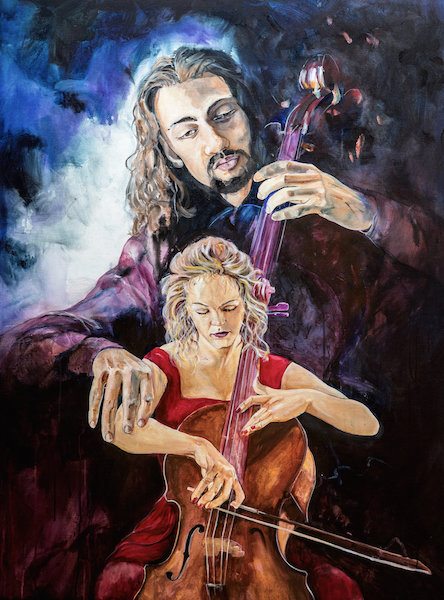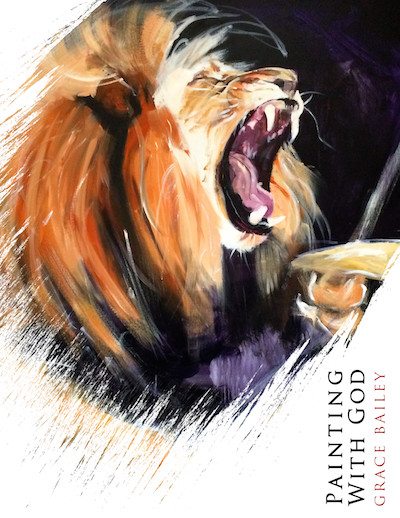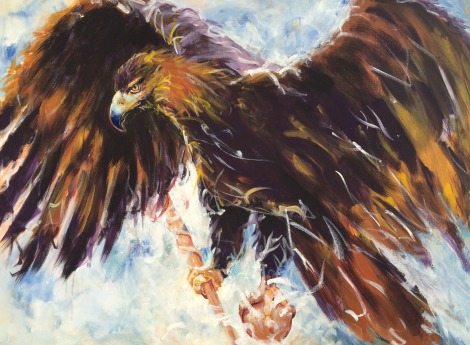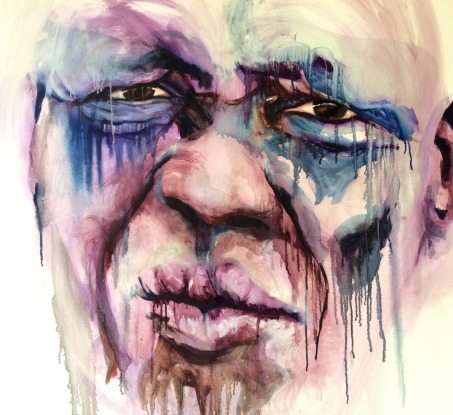Do Skills Matter in Prophetic Art?

Skills building for artists involved in prophetic live art are imperative as creating an image of any kind of standard quickly is no mean feat. I’ve found some real challenges with Iive painting. Of the sixty-six works that I produced during the year of live worship painting, approximately thirty percent were successful enough that I was happy to publish them. That is, they were works that I was really pleased with. Another forty percent were passable enough to land in the okay category, (not works that I’d want largely published but not complete failures either.) Twenty percent had the potential to be salvaged with a lot of work at home. The other ten percent were paint-over-and-start agains! That means that approximately six weeks out of the year produced works that needed to be completely redone or painted over and another ten weeks had very ho-hum results.
So even with decades of experience and well over 10,000 hours of arts practice, I still created works ten percent of the time which were complete failures, and another thirty percent of the time that weren’t exactly excellent!

Lifting the Bar
There has been a great deal written about worship leading, performance and song-writing which can be used to inform the creation of art in a worship setting. In fact that’s where I’ve been able to source some understanding about the whole process. Anyone wanting to join a worship team would not expect to play publicly after only a couple of lessons, nor would they expect to do their own thing. There is an expectation that worship performers and leaders put in the hard yards to master their instrument and their ability to use it. I believe it is the same with worship artists. We need to hone our skills and application.
There are clear parameters of what is good and what is not in music and musicianship that are lacking in art. I’ve heard it said that there is no bad art, but there is a great deal of not so good art. Since the advent of abstract art, it is harder to define what good art is but it is usually not hard to define what bad art is. It’s art that you don’t want to look at. If it is so poorly done that you don’t want to look at it, you’re less likely to remember it.
I’ve seen many pieces of prophetic or worship art with amazing concepts and layers of meanings that were compromised by poor execution. I believe a large reason for this is the lack of skills acquisition and the current tendency to focus more on the message than the resultant image.
I often wonder why the church has such high expectations of quality from its musicians and singers but accepts the efforts of beginner artists in a public service. I recognize that they may be very sincere and earnest but if we wouldn’t accept beginner musicians, why then do we accept beginner artists? I can’t get around the observation that the church seems to have such high standards for its music that it can compete on the world stage and that has literally reached extraordinary audiences worldwide (such as Hillsong and Bethel Music) while the standard of Christian art remains largely ho-hum. It could be likened to the level attained when church music was a solo organ or piano. Culturally, that’s no longer acceptable, but much worship art is still largely back there in standard. I really believe that there is a key there that we as artists need to recognize and embrace.
I realize that this may seem to be a contentious issue and it is definitely not my intention to offend anyone, but if the church is truly to reclaim art and move into a renaissance of creativity, the current practice of dual standards of excellence in music but anything-goes-in-art can’t continue. One of the initial reservations I had about painting prophetically was because I had such a poor opinion of Christian art. As mentioned previously, some of that was due to my disparagement of the iconography, but the rest was due to never having seen much good Christian art. If the only prophetic art that people see is that which is produced in church and that standard is not high, those people may never appreciate the true worth of it.
We should pursue excellence that glorifies Almighty God.
That doesn’t mean that all prophetic artists should conform to the same style or standards, but it does mean that the need for excellence needs to be a primary concern when painting publicly. As I’ve said before, not all works turn out to be great or could be said to be even ‘good’. I’ve certainly had lots of dud works including most of a week at a conference in Queensland towards the end of the 52 week challenge. In other words, I‘ve been painting for years, and prophetically painting a great deal, and I still have works that don’t make the grade. Does that mean then that the less-competent artist should stop painting? Not at all! In fact, it means more painting, more practice, more research of techniques and methods, more learning and more skilling. That’s where I’m at. Of course, it would be fabulous if those painting angels would come alongside each time and hold my brush or whisper colors or in fact, yell loudly before I wreck a painting, but that doesn’t seem to always happen!
It means that beginner artists should put in the hard yards with skill development before public worship painting. Practice means to actively ask God for images to paint, research them, refine them, use reference images, consider colors, placement, proportion, message, media, lighting, and the myriad of other elements and create it at home. Do practice runs until the standard is high enough for public airing. Then you can go forward with confidence that your image will resonate because of a higher standard. This takes discipline and application.
Personal worship is just that and should remain so until the level of skills attained approaches the level of musicianship from the worship team. A good standard to use might be to ask the keyboard player or the worship leader how many years they’ve been playing, or even how long they’ve been learning, and look at that as a rough ballpark. Of course pure practice without growth or improvement can be a waste of time, so it’s important that it be directed and perhaps critiqued by an objective party rather than just the well meaning and kind members of the local congregation.
All of this is about raising the standard of worship and prophetic art. It is most definitely not meant to disparage or offend any aspiring artist, and neither am I setting myself up as any kind of guru or master. Striving for perfection is a plague that nips at artists’ heels by constantly resetting the goal posts further and further away, but this is obviously not what I’m advocating. Rather I am expressing my belief that we should pursue excellence that glorifies Almighty God.
But isn’t the Message More important?
If worship art is a message from God in visual form, isn’t it more important to relay what God has said than to produce a beautiful work? Isn’t a focus on execution elevating the artist rather than God? On the contrary, I believe that worship and prophetic painting is a collaboration between the artist and God, but if the image is so poorly done that few people want to look at it, the message lacks the impact it would otherwise have had and God’s message is lost anyway.
In particular, I believe that skilled drawing using reference images is imperative. I wouldn’t dream of painting an image without reference photographs to create the initial drawing and to paint the image as I just don’t know what most things really look like. For instance, I’ve painted a number of lions and eagles. Until I studied close-up photographs of them I had only the vaguest idea of what a lion or an eagle looked like. If I’d tried to paint one, it would have ended up looking very amateurish. Even now, when I’ve painted multiples of each, I would be very reluctant to paint either without a reference image because I want to create the best images I can, especially in public worship where there is limited time. Even though I’ve done both multiple times, I still wouldn’t be able to get proportions, color and light correct without reference images.

When God gives an artist an image, I don’t believe He expects them to reproduce it exactly. In fact, most times the resultant image looks a lot different anyway as the artist’s ability and ongoing inspiration or the actual process involved alters the original concept. I’ve tried to reproduce ideas that God has given me exactly as I first saw them, but they never work out as envisaged.
I’ve realized now that that initial image is meant to be the seed of the idea and the artist is then meant to build on the concept and create in collaboration with the supernatural. The closest I can come to a comparison is when you start to prophesy and only get a glimpse or a word, but as you begin to speak it out, more comes. It is the same with worship art. We aren’t meant to reproduce mirror images (which is humanly impossible) of what we’ve originally envisaged but to construct and create around the ideas.

To give an example, I saw a vision of myself playing a cello during a soaking session where I’d been in prayer and just quietly waited on God. In the vision, I was playing a cello on a stage under a spotlight. The scene widened to reveal Jesus playing alongside me on my right. I exclaimed in surprise that I was only learning. Then the scene widened again to reveal a very grand, full theatre in front of us, with the audience dressed in beautiful clothes listening to us play. We were on the stage under spotlights and the music was poignant and powerful. There was a sense that the listeners were enraptured.
I turned to look at Jesus but He’d disappeared. In the next scene, I could see from the viewpoint of the audience and I saw Jesus as very large behind me before He merged to play through me. The music we were playing looked like flakes of silver, floating out from the instrument. I interjected that the flakes should be gold as well. Afterwards, I looked up the meaning of a cello, which means ‘creative achievement and displaying much strength and stability’. Silver means a variety of things, from redemption to money to intuition.
In order to create a painting based on that experience, the image needed to be translated into a 2D format, but I’d seen it in 3D form. I searched till I found an image of a female and then a male playing the cello and duly drew them onto the canvas using the grid system intending to alter each in the painting process. My concern at the time was in being able to fit them both onto the surface and with having them more or less fit proportionately together. Entirely unbeknownst to me, the shaft of both cellos lined up so it looks like Jesus is playing the same instrument as the woman. It hadn’t occurred to me before to paint it like that, it just worked out and I didn’t even realize it till I’d painted it!
The work represents a collaboration between what I saw during the soaking session and what I eventually produced, using several reference images. Clearly, the composition and painting method were influenced by Holy Spirit, but I didn’t try to reproduce the exact image of what I’d seen. As well, I spent a lot of time thinking about how to render that work, what colors to use and how I’d paint it before live painting it. Those intentions morphed and altered during painting, but I’d put the effort in beforehand so it ended up as a reasonably competent work.
Start Your Own Prophetic Art Adventure With The 'Painting With God" book.

You'll be guided by experienced artist, Grace Bailey, through ten colorful chapters on how to get started, face your fears and create images that tell God-stories.

What if it’s really bad?
It’s not always possible to do a great work, in fact, it’s really difficult to do your best when you are working quickly in front of an audience such as during worship. Time constraints, difficult lighting and all sorts of issues can get in the way. You usually aren’t able to get back and look at the work to study what’s wrong with it so the potential to create a great work is greatly compromised. This is where the need to hone skills comes in.
Even with extensive skills acquisition, ‘good’ works aren’t always attained. During my 52 weeks of live worship art I had many works which I’d have preferred not to have had a public viewing. I’d started with a good idea but the execution was second-rate and those works were later overpainted. Often the failure was due to insufficient preparation but sometimes they just didn’t work for no identifiable reason. One of the important things about worship art is that while you strive to do your best, you also need to be prepared for the public flop. Everyone else can see your work except you and then you step back and don’t want to look at it! There’ve been a number of times that I wanted to turn a work around and hide it. Just as a singer can have a bad session, a painter can also have an ‘off’ day which is why it’s so important to build skills to lessen the likelihood of flops.
The live worship artist needs to be prepared for occasions when, despite their best efforts, their work fails publicly which can be very humiliating. Everyone else can see what’s wrong with it except the artist! Sometimes after painting I’ve felt like I wanted to crawl under the chair and hide when the work failed. An experience or two like that could prompt the artist to refuse to worship paint anymore for fear of failure which is also an ego issue if you think about it. When I first started the year of live painting, I launched into it believing that God wouldn’t allow me to fail. After all, I was doing His work wasn’t I? However, as I mentioned before, nearly 10% were complete paint-overs and another 15-20% were pretty ho-hum. That means that I painted publicly almost a third of the year and had disappointing results. The output from a third of the year was much less than successful and at the very least needed extensive repainting at home in the studio if not complete redoing. Some of the topics I painted for those works were ones that I was certain were God messages but for one reason or another, I didn’t pull them off well. I can’t even identify why they didn’t work either. Some of the repaints I may revisit at a later date, some I just don’t want to touch. I think it was about trusting regardless and not putting my agenda or pride out there.

Beauty in Art
An aspect of art that has been seemingly lost in Australia is beauty. If a work is beautiful or evoking an atmosphere of serenity, it is often lampooned as ‘chocolate box’ meaning the kind of image once used on boxes of chocolate and therefore not ‘real’ art. When I did my masters degree, I painted a body of large portraits of a range of people. One of those portraits was of a beautiful young woman who had chosen to remain a virgin well into her twenties. I painted her as I saw her; beautiful. The supervisor for my Masters comment was ‘if you put that in you’ll commit hari kari’. I ended up pouring a lot of black paint over much of the painting and submitted it. I passed.
Sometimes it seems that ‘anti-beauty’ is acceptable but the depiction of beauty is not. I believe that this is a highjacking of one of the purposes of art by darker spiritual forces. If art is so ugly that you don’t want to look at it or the meaning so obtuse that you don’t know what it’s about, it probably negates it’s worth. By ugly, I mean poorly done as opposed to unpleasant imagery. By poorly done, I mean stiff figures and out of proportion features or discordant garish colors or a whole host of other features. I don’t mean unpleasant subject matter. George Gittoes, Kevin Carter’s works and the Nick Ut’s Vietnam “Napalm Girl” photo (17) were all unpleasant but well executed and got their message across.
In fact Ut’s photo is credited with turning the tide of opinion which ultimately led to the American withdrawal from that war. George Gittoes’ (18) works are terribly gruesome but they are executed so skilfully that they communicate deeply, in particular, the horrors of the Rwandan war and Pol Pot’s genocide. The 1993 photo of the little Sudanese girl dying of starvation while the vulture sat waiting (19) was similarly not pleasant to look at but ultimately galvanised real aid for that famine. So of course not every work should be beautiful to look at but it should be skilfully created if it is to represent the Father’s heart in a public forum.

Specialising
Quite a few years ago I heard a sermon relating the concept that the energy needed to power a 60 watt incandescent bulb could cut steel if it were focused through a laser beam. This impacted me greatly as I had done what many artists do, spread my arts practice widely across many types of media rather than focusing on becoming the best I could in one particular field. In fact, at one stage, I even prided myself that I had enough understanding of so many fields of painting such as watercolor, pastel, mixed media, oils, acrylics, portraiture, drawing, ceramics and some sculpture that I could teach a very broad field. A broad understanding is good if you want to be a teacher, a deep understanding is what is necessary if you’re aiming for expert execution.
While I’ve had a lot of fun over the years dabbling in this and that, now I recognise that my time would have been much better spent developing my skills to be the best they could be in one field rather than spreading across many media. Now as I look around at secular standards in concept art, I realise that I’ve wasted a lot of time and never really developed in one particular area. Many years of skill development spread widely rather than focused intently has meant broad skills rather than super- fabulous specialisation. Certainly I concentrated on large scale oil portraits for a time and reached a reasonable level of facility but then I changed direction and started using acrylics so I’ve had to learn a whole new method of application. I’ve got justifiable reasons for this (I’ve moved into rapidly produced prophetic art) but the principle still raises the question of just what would I have been capable of with enough practice and development? Now looking back, I wish I had understood the concept of pursuing skill development earlier as opposed to the academically imposed experiential self-expression type of art with no parameters of what really constitutes quality.
I’ve seen this quite a lot in developing artists and other creatives. To put it into perspective, recently I had a conversation with a writer who often sees visions that she’d like to translate into an image. However, while her writing is highly developed and polished, her art skills are rudimentary. She could choose to wander off task and develop those art skills over many years so that she could paint them or more sensibly, she could sketch the ideas for an established artist to translate, thereby using both sets of expertise at a much higher level and go on working in her strength, writing.
There’s an educational theory which promotes concentrating a student’s learning to improve their weaknesses rather than encourage them to pursue their strengths and see what they can achieve. For instance, if a student performs poorly in reading, they might be given extra help with that but if a student excels in an area, it’s unlikely the school will put more resources towards advancing that subject (unless it is sport in Australia!). This has a correlation in society as well in that many people believe they need to improve their weaknesses rather than focus on their strengths. While there can be value in this, it can also be a way to waste a lot of time and energy. Of course totally ignoring areas that need attention is not what I’m advocating. It’s more of a call to recognise strengths and develop them rather than labouring excessively over weaknesses.
For an artist this means recognising their area/s of strength such as drawing or composition or color and developing that rather than stressing over what they’re not good at. Lest it sound as if I’m contradicting myself with the call for skill building, lets look at it through musicianship. A keyboard player develops proficiency on the keys by practicing their instrument, not by taking up the banjo, drums and bass. An artist achieves their greatest level of competency by years of focused practice and development.
Even the centuries old practice of life-drawing as the key to learning to draw has been warped by the lack of emphasis on specialised skill development. Most life-drawing classes now consist of standing before a naked body and drawing it without much instruction as opposed to principled skill advancement because the teachers didn’t learn academic drawing.
I’m very encouraged by the opportunities presented by being able to communicate with serious quality artists from around the world. The extraordinary skill levels shown by some of them are truly remarkable and set standards which should not be intimidating but encourage others to push towards.

Competing in a Secular Field
When I started the year of live worship painting, I decided that I wasn’t going to enter competitions or pursue exhibitions anymore. Rather I determined that I was going to focus purely on creating prophetic art which I thought was a noble cause at the time. I was eschewing the possible monetary gain and going after God’s purposes, wasn’t I? In retrospect, I think that decision had more to do with retreating into a comfortable place where my art was accepted and I had easy recognition than in serving God or being set apart to only paint ‘God’ pieces.
Certainly, most prophetic art would only appeal to Christians because of the subject matter but what if it were good enough to have a wider audience? To do that, it would have to display the kind of skill level that what I call the new breed of artists show. By the new breed, I mean the young artists who often use digital technology to enhance or create their works. Clearly, that’s not something that I’ve seen happen during worship but it can with prophetic art that is produced at a slower and more considered pace.
This new breed of artists, that is the digital and graphic artists, often display extraordinary skills. Sites such as Society 6 and any number of print-on-demand decor sites have breathtaking images and those artists can earn commensurately because they’ve built extensive skills and use them well. It’s clear that many don’t go through fine arts degrees but go after skills acquisition rather than conceptual arts learning.
I use the word ‘art’ a little trepidatiously as it’s meaning in our society has been somewhat hijacked. We’re surrounded by imagery every day, some of which is truly magnificent, but with the bombardment comes a taking for granted. We have learned to switch off to the sales hype, ignore the billboards and miss the art. Kids in schools in Australia grow up with little aesthetic awareness.
Art should uplift us or educate us or communicate to us, but sadly, we are surrounded by images that we can be oblivious to because they are usually trying to sell us something. Original art is locked away in the rarified atmosphere of white walled over-priced galleries amidst layers of pseudo intellectualism that causes many people to murmur “I don’t know much about art but I know what I like”.
What this has seemed to create in Christian art is the sentiment that anything goes and that there is no ‘bad’ art. In terms of art that is an expression of your own experiences, revelations or relationship with God, there is no ‘bad’ art. But when it enters a public domain, I believe we have a responsibility to create the best we can. Just as we are told to ‘make a joyful noise’ (20) as opposed to sing like an angel, God accepts our intimate offerings of praise regardless of our ability. But personal expression is a different thing to the corporate, public display of worship art.
In order to lift the standard of public worship art, extensive skill building is a basic requirement. Just as only a few people can play an instrument by ear, only a few people are natural drawers. The rest have to learn to draw. Similarly, most people starting out have issues applying paint and have to learn how to create form, composition, and blend tone without creating mud. Unfortunately, there seems to be the concept that the application of the idea is enough without the skills acquisition, which I believe, cheapens the whole field.
Not every work an artist creates is going to be good or great, but the more skills accumulated along the way, the greater the chance that a good one may eventuate. Lest all this insistence on refining skills sound like I’m trying to deter people from painting live, that is definitely not my intention. Rather it is a call to pastors and artists alike for self-reflection and analysis as well as discussion about the purposes, heart and outcomes surrounding live worship art. It is my sincere hope that that expands and more people can do it, but it is also my sincere hope that we, the church, begin to assess the quality with a more discerning attitude.
Start Your Own Prophetic Art Adventure With The 'Painting With God" book.

You'll be guided by experienced artist, Grace Bailey, through ten colorful chapters on how to get started, face your fears and create images that tell God-stories.
